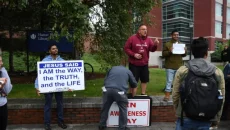Just a mere two years earlier, students on campus faced clouds of smoke upon exiting buildings, walking through the gazebo on south campus, and outside their dorms. Ashtrays and littered cigarette butts could be found in every entryway. The option to smoke was everywhere, but those who didn’t were left to breathe the fumes. What could be done to resolve this issue without dividing those who smoke and those who don’t?
UMass Lowell initiated its tobacco-free campus policy in September of 2014 with the approval of former chancellor Marty Meehan. Although there was a large controversy over the new rules and regulations regarding smoking on campus, in recent months and in the past year, students who do and do not smoke appear to have mutually settled on the situation.
The tobacco-free campus policy is both backed and enforced by students and student officials. Amanda Robinson, the chair of the campus life and environmental committee from the fall of 2013 to the spring of 2014, developed the Tobacco Free Coalition. This initiative was never designed to have a strict enforcement or segregate students who smoke, but simply to create an atmosphere that best adapts to all students, whether they smoke or not. Amanda said, “It was time for us to be a university that recognizes a tobacco free environment is the best environment for living and learning.”
The university becoming tobacco-free provided funding and grants that is used toward programs and awareness about the risk factors of smoking cigarettes and how to quit, which are still offered around campus and in the Wellness Center at University Crossing.
According to the vice president of the Student Government Association (SGA), Jesse Krusczka, for the first year or so the primary objective has been to simply “notify students and acknowledge the policy has been implemented,” which is still in effect. The extent of enforcement involves members of residence life and SGA, as well as other student officials, simply and politely asking users of tobacco products to move away from campus buildings, which could mean to the sidewalk or across the street.
One way of increasing the knowledge and awareness of the tobacco- and smoke- free policy was increasing the amount of signage around campus, displaying that smoking is prohibited in those specific locations. After researching other universities and their tactics for preventing smoke on campus, Amanda Robinson concluded, “[The] best way to enforce the policy was to make not smoking a social norm on campus. Research from other universities suggests that most students would not smoke next to a no smoking sign because it is not a social norm.”
Because the university is tobacco-free – in addition to cigarettes, cigars and other tobacco products – tobacco vaporizers are also prohibited. E-cigarettes are debatable due to the fact that they are not specifically written in the approved policy. Going forward, according to Kruszka, the SGA hopes to implement the policy more, but as of right now its main purpose is to inform students that the campus is smoke-free, and, if they wish to quit, where to find information or programs.



